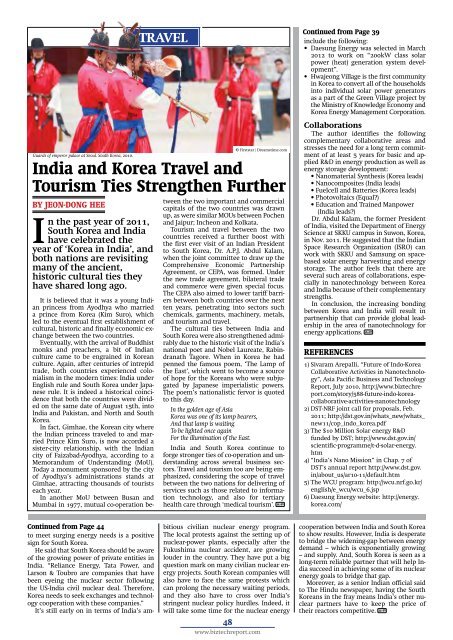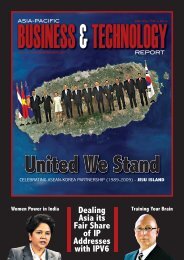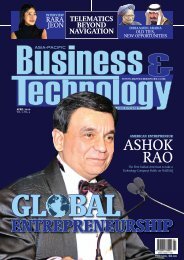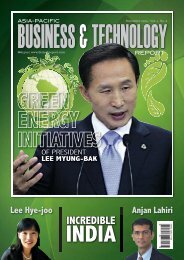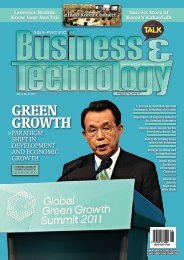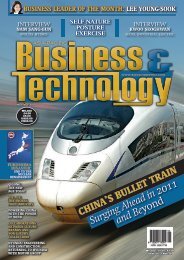INDIA-KOREA - Asia-Pacific Business and Technology Report
INDIA-KOREA - Asia-Pacific Business and Technology Report
INDIA-KOREA - Asia-Pacific Business and Technology Report
Create successful ePaper yourself
Turn your PDF publications into a flip-book with our unique Google optimized e-Paper software.
Guards of emperor palace at Seoul. South Korea, 2010.<br />
India <strong>and</strong> Korea Travel <strong>and</strong><br />
Tourism Ties Strengthen Further<br />
BY Jeon-Dong Hee<br />
In the past year of 2011,<br />
South Korea <strong>and</strong> India<br />
have celebrated the<br />
year of ‘Korea in India’, <strong>and</strong><br />
both nations are revisiting<br />
many of the ancient,<br />
historic cultural ties they<br />
have shared long ago.<br />
TRAVEL<br />
© Firststar | Dreamstime.com<br />
It is believed that it was a young Indian<br />
princess from Ayodhya who married<br />
a prince from Korea (Kim Suro), which<br />
led to the eventual first establishment of<br />
cultural, historic <strong>and</strong> finally economic exchange<br />
between the two countries.<br />
Eventually, with the arrival of Buddhist<br />
monks <strong>and</strong> preachers, a bit of Indian<br />
culture came to be engrained in Korean<br />
culture. Again, after centuries of intrepid<br />
trade, both countries experienced colonialism<br />
in the modern times: India under<br />
English rule <strong>and</strong> South Korea under Japanese<br />
rule. It is indeed a historical coincidence<br />
that both the countries were divided<br />
on the same date of August 15th, into<br />
India <strong>and</strong> Pakistan, <strong>and</strong> North <strong>and</strong> South<br />
Korea.<br />
In fact, Gimhae, the Korean city where<br />
the Indian princess traveled to <strong>and</strong> married<br />
Prince Kim Suro, is now accorded a<br />
sister-city relationship, with the Indian<br />
city of Faizabad-Ayodhya, according to a<br />
Memor<strong>and</strong>um of Underst<strong>and</strong>ing (MoU).<br />
Today a monument sponsored by the city<br />
of Ayodhya’s administrations st<strong>and</strong>s at<br />
Gimhae, attracting thous<strong>and</strong>s of tourists<br />
each year.<br />
In another MoU between Busan <strong>and</strong><br />
Mumbai in 1977, mutual co-operation between<br />
the two important <strong>and</strong> commercial<br />
capitals of the two countries was drawn<br />
up, as were similar MOUs between Pochen<br />
<strong>and</strong> Jaipur; Incheon <strong>and</strong> Kolkata.<br />
Tourism <strong>and</strong> travel between the two<br />
countries received a further boost with<br />
the first ever visit of an Indian President<br />
to South Korea, Dr. A.P.J. Abdul Kalam,<br />
when the joint committee to draw up the<br />
Comprehensive Economic Partnership<br />
Agreement, or CEPA, was formed. Under<br />
the new trade agreement, bilateral trade<br />
<strong>and</strong> commerce were given special focus.<br />
The CEPA also aimed to lower tariff barriers<br />
between both countries over the next<br />
ten years, penetrating into sectors such<br />
chemicals, garments, machinery, metals,<br />
<strong>and</strong> tourism <strong>and</strong> travel.<br />
The cultural ties between India <strong>and</strong><br />
South Korea were also strengthened admirably<br />
due to the historic visit of the India’s<br />
national poet <strong>and</strong> Nobel Laureate, Rabindranath<br />
Tagore. When in Korea he had<br />
penned the famous poem, ‘The Lamp of<br />
the East’, which went to become a source<br />
of hope for the Koreans who were subjugated<br />
by Japanese imperialistic powers.<br />
The poem’s nationalistic fervor is quoted<br />
to this day.<br />
In the golden age of <strong>Asia</strong><br />
Korea was one of its lamp bearers,<br />
And that lamp is waiting<br />
To be lighted once again<br />
For the illumination of the East.<br />
India <strong>and</strong> South Korea continue to<br />
forge stronger ties of co-operation <strong>and</strong> underst<strong>and</strong>ing<br />
across several business sectors.<br />
Travel <strong>and</strong> tourism too are being emphasized,<br />
considering the scope of travel<br />
between the two nations for delivering of<br />
services such as those related to information<br />
technology, <strong>and</strong> also for tertiary<br />
health care through ‘medical tourism’. A-P<br />
Continued from Page 39<br />
include the following:<br />
• Daesung Energy was selected in March<br />
2012 to work on “200kW class solar<br />
power (heat) generation system development”.<br />
• Hwajeong Village is the first community<br />
in Korea to convert all of the households<br />
into individual solar power generators<br />
as a part of the Green Village project by<br />
the Ministry of Knowledge Economy <strong>and</strong><br />
Korea Energy Management Corporation.<br />
Collaborations<br />
The author identifies the following<br />
complementary collaborative areas <strong>and</strong><br />
stresses the need for a long term commitment<br />
of at least 5 years for basic <strong>and</strong> applied<br />
R&D in energy production as well as<br />
energy storage development:<br />
• Nanomaterial Synthesis (Korea leads)<br />
• Nanocomposites (India leads)<br />
• Fuelcell <strong>and</strong> Batteries (Korea leads)<br />
• Photovoltaics (Equal?)<br />
• Education <strong>and</strong> Trained Manpower<br />
(India leads?)<br />
Dr. Abdul Kalam, the former President<br />
of India, visited the Department of Energy<br />
Science at SKKU campus in Suwon, Korea,<br />
in Nov. 2011. He suggested that the Indian<br />
Space Research Organization (ISRO) can<br />
work with SKKU <strong>and</strong> Samsung on spacebased<br />
solar energy harvesting <strong>and</strong> energy<br />
storage. The author feels that there are<br />
several such areas of collaborations, especially<br />
in nanotechnology between Korea<br />
<strong>and</strong> India because of their complementary<br />
strengths.<br />
In conclusion, the increasing bonding<br />
between Korea <strong>and</strong> India will result in<br />
partnership that can provide global leadership<br />
in the area of nanotechnology for<br />
energy applications. A-P<br />
References<br />
1) Sivaram Arepalli, “Future of Indo-Korea<br />
Collaborative Activities in Nanotechnology”,<br />
<strong>Asia</strong> <strong>Pacific</strong> <strong>Business</strong> <strong>and</strong> <strong>Technology</strong><br />
<strong>Report</strong>, July 2010, http://www.biztechreport.com/story/588-future-indo-koreacollaborative-activities-nanotechnology<br />
2) DST-NRF joint call for proposals, Feb.<br />
2011; http://dst.gov.in/whats_new/whats_<br />
new11/cop_indo_korea.pdf<br />
3) The $10 Million Solar energy R&D<br />
funded by DST; http://www.dst.gov.in/<br />
scientific-programme/t-d-solar-energy.<br />
htm<br />
4) “India’s Nano Mission” in Chap. 7 of<br />
DST’s annual report http://www.dst.gov.<br />
in/about_us/ar10-11/default.htm<br />
5) The WCU program: http://wcu.nrf.go.kr/<br />
english/e_wcu/wcu_6.jsp<br />
6) Daesung Energy website: http://energy.<br />
korea.com/<br />
Continued from Page 44<br />
to meet surging energy needs is a positive<br />
sign for South Korea.<br />
He said that South Korea should be aware<br />
of the growing power of private entities in<br />
India. “Reliance Energy, Tata Power, <strong>and</strong><br />
Larson & Toubro are companies that have<br />
been eyeing the nuclear sector following<br />
the US-India civil nuclear deal. Therefore,<br />
Korea needs to seek exchanges <strong>and</strong> technology<br />
cooperation with these companies.”<br />
It’s still early on in terms of India’s ambitious<br />
civilian nuclear energy program.<br />
The local protests against the setting up of<br />
nuclear-power plants, especially after the<br />
Fukushima nuclear accident, are growing<br />
louder in the country. They have put a big<br />
question mark on many civilian nuclear energy<br />
projects. South Korean companies will<br />
also have to face the same protests which<br />
can prolong the necessary waiting periods,<br />
<strong>and</strong> they also have to cross over India’s<br />
stringent nuclear policy hurdles. Indeed, it<br />
will take some time for the nuclear energy<br />
48<br />
www.biztechreport.com<br />
cooperation between India <strong>and</strong> South Korea<br />
to show results. However, India is desperate<br />
to bridge the widening-gap between energy<br />
dem<strong>and</strong> – which is exponentially growing<br />
– <strong>and</strong> supply. And, South Korea is seen as a<br />
long-term reliable partner that will help India<br />
succeed in achieving some of its nuclear<br />
energy goals to bridge that gap.<br />
Moreover, as a senior Indian official said<br />
to The Hindu newspaper, having the South<br />
Koreans in the fray means India’s other nuclear<br />
partners have to keep the price of<br />
their reactors competitive. A-P


